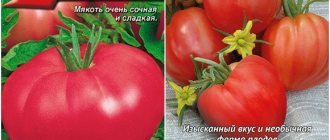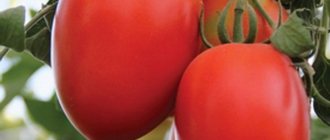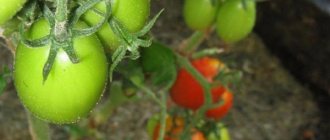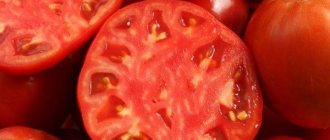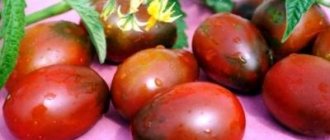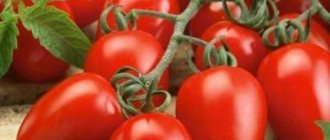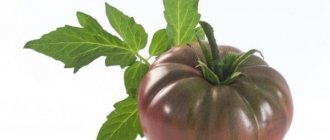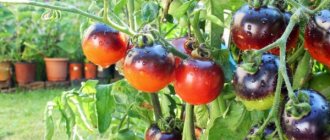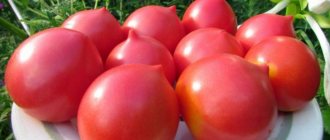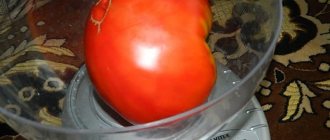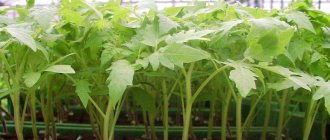History of the variety's creation
The Caspar tomato was created in Holland in a well-known company called Royal Slus. This company is very popular due to the quality of its products. This variety was not included in the State Register, but even without this it is popular among vegetable growers.
The Caspar tomato variety can grow in different areas, both in the southern and northern regions. The only difference in cultivation is that in the southern regions the variety is grown in open ground, and in the northern regions it must be grown indoors.
Features of cultivation
The basis of a good harvest is compliance with the rules of agricultural technology. It is recommended to cultivate the Caspar tomato in seedlings.
Planting seedlings:
- Seeds, if they are not purchased in a specialized store, must be disinfected. To do this, place them in a manganese solution for 20-30 minutes (1 g of the drug per 100 ml of water).
- Wash the containers thoroughly, dry them, and make sure there are ventilation holes.
- Fill the container with soil purchased from the store. If the soil is homemade, then it must be calcined in the oven at 100 °C for 1 hour.
- Form grooves in the ground to a depth of 1 cm, maintaining a distance between them of 3 cm. Place the seeds in the grooves, maintaining a distance of 2 cm, and sprinkle them with soil.
- Cover the container with glass or film and move it to a warm, draft-free window sill.
When shoots appear, remove the film, and all care will consist of watering, ventilation, and providing sufficient light.
Important! The optimal time for sowing is the last week of February or the beginning of March.
Plants should be transferred to open ground after they have become stronger and a warm climate has established, at the end of May. A couple of weeks before planting, young tomatoes need to be hardened off. To do this, they are taken outside on sunny days, gradually increasing the time they spend in the air.
When forming beds, it should be taken into account that it is recommended to place no more than 3 copies per 1 m2
Add 10 g of superphosphate into the prepared hole, then place the seedling there and cover the root with soil on top. Water the plant generously.
Further care consists of loosening and moistening the soil, timely removal of weeds, and mulching. Caspar tomatoes need to be formed into 1-2 stems. Fertilizing should be applied after the formation of the ovaries, and then regularly repeated 2-3 more times during the season.
It is recommended to garter as soon as the plant gets stronger, this will facilitate the process of formation as the bush grows
Tomato Caspar: characteristics and features of the variety
Tomato Caspar: photo of variety
- The bush has well-developed foliage. Therefore, when grown in the southern territory, it will provide the bush with protection from burns. It is worth noting that when growing the variety in the northern territory, the bush will need an additional light source, since the variety is light-loving.
- The Caspar tomato belongs to the Determinate species. Therefore, it has a fairly low bush, about 60 centimeters in height, and it is quite compact. If the variety is grown indoors, the height can reach up to 110 centimeters.
- Experts say that pinching is not necessary for the Caspar tomato variety if it grows in the southern territories. If the variety does not grow in the south, then pinching and formation are carried out, but thanks to this the fruits will ripen ahead of schedule.
- The tying of Caspar tomatoes must be carried out and this is a mandatory procedure. Since the variety is a high-yielding variety, branches without support will break under the weight of the fruit.
- The Kaspar tomato variety belongs to the average ripening period. Therefore, the first harvest can be harvested 90 days after the first shoots appear. In closed ground, the first harvest ripens within 80 days.
- The Kaspar tomato has a high yield. Despite its compactness, it can yield 2-3 kilograms from each bush.
- The fruits of this variety have a slightly elongated shape and also have a characteristic sharp end.
- Tomatoes have a bright red hue and can weigh up to 130 grams.
- The skin of the fruit is quite thick and durable, the flesh is sweet, but there is a slight sourness. The aroma of tomatoes is very pleasant. Due to the strong skin, the fruits never crack.
- In the cross section of the fruit you can see 1-3 chambers where the seeds are located; 3 chambers are very rare. Therefore, in general, the fruit consists only of dense and fleshy pulp.
- The Kaspar tomato variety is considered universal and can be used in cooking, especially in canning: preparing tomato paste, juice, pickled tomatoes. Since the skin is thick, it needs to be removed, and it comes off very easily even without using hot water.
- High resistance of Caspar tomatoes to diseases such as fusarium and verticillium.
Note: Tomato Kaspar f1 has a long shelf life. After harvesting, the fruits can be stored for about 50 days without changing their aroma, taste or appearance.
I would like to say that the Kaspar tomato, a few years after its creation, was slightly improved and became known as Hypil. This variety ripened early and changed its shape, which became similar to a pear. The rest of the qualities remained the same.
Russian breeders also slightly changed the Kaspar f1 variety. Breeder Anatoly Lukyanenko, together with the company, after research and experience, received a new hybrid, which was named Kaspar 2 tomato. This variety has already been included in the State Register.
Pests and diseases
Breeders develop hybrids with high immunity. This criterion is one of the main ones for a summer resident when choosing any category of plants. After all, disease-resistant crops are easier to grow.
Caspar tomato, which resists the following diseases:
- fusarium wilt;
- verticillium wilt.
It is attacked by aphids. It suffers especially badly from late blight and blossom end rot.
Preventive treatment of plants will help save the bush from losing part of the harvest.
Tomato Kaspar 2: variety description
Tomato Caspar: photo of variety
- Belongs to the determinant type.
- The bush reaches about 85 centimeters in height.
- The tomato variety Caspar 2 has an average ripening period, the first harvest is harvested after 95 days.
- This bush requires formation; the best choice would be formation into 2 stems.
- The fruits of the Kaspar 2 tomato are cylindrical in shape, each tomato weighs about 100 grams. Often used for pickles. It differs from Kaspar 1 in that it contains several times more sugar.
Planting seedlings
The Caspar tomato variety is grown only from seedlings. Therefore, planting high-quality seedlings is important, as it guarantees that the bush will develop well and bring a large harvest. Sowing of seedlings begins in early spring, or rather in the second half of March.
Instructions for sowing seedlings.
- First you need to prepare the Caspar f1 tomato seeds, which will be planted in the ground. These seeds can be purchased in special stores. Such planting material will already be processed and disinfected.
- Seeds are planted dry without additional soaking.
- The soil for sowing is taken from the garden plot. Before use, you need to warm it up a little in the oven.
- Tomato seeds Caspar f1 are sown in furrows, covered with soil and sprayed with warm water. After which they are covered with film for 6 days.
- After the first shoots have appeared, certain criteria must be observed for the place where the seedlings will be stored. The temperature should be about +19 degrees at night and +23 degrees during the day. Good lighting is a must; if there is not enough light, you can use a fluorescent lamp. Watering should be done 1-2 times a week. And during the development of seedlings, 2 fertilizer applications should be made to the soil. Only mineral fertilizers should be applied and in small quantities.
- When two full leaves appear, the sprouts are transplanted into separate containers. Transplanting into separate containers stops the development of the sprout for 5-6 days. To prevent this from happening, the seeds can be sown individually at once.
- Before transplanting, about 15 days before, you need to start hardening the bush. To do this, the plant must be taken out into fresh air every day. The time spent in the fresh air increases daily, from 40 minutes to 24 hours.
Transfer
After the soil has warmed up and the temperature in it has become at least +17 degrees, you can replant the plant in open or closed ground.
The place where the plant will grow must be prepared in the autumn. The soil is fertilized by adding humus and fertilizers containing phosphorus. Nitrogen and potassium fertilizers are applied in the spring, 20 days before transplanting.
Note: Nitrogen and potassium fertilizers will wash into the lower layer of soil with water.
Planting of Kaspar f1 tomatoes is carried out according to a special scheme. There should be 70 centimeters between rows, and about 45 centimeters between bushes. Before transplanting, 30 grams of humus and 2-3 grams of any mineral fertilizer, as well as 20 grams of wood ash, are placed in each hole.
All ingredients of the mixture must be well mixed with the soil. Before planting, you need to thoroughly shed the soil. This will prevent injury to the tomato root system.
Note: If it happens that the Caspar f1 tomato seedlings become too large, you need to dig a ditch instead of a hole. Also, from such seedlings you need to remove 3 leaves at the bottom. And plant them to the north, guided by the top of the head. With such planting, additional roots appear in the tomato root system, which will further strengthen it in the soil.
After replanting, it is necessary to mulch using straw, hay or dried grass clippings. You also need to shade using arcs and placing, for example, Lutrasil on them. Lutrasil is a non-woven material; any other material will do instead.
The plant should be watered only 8 days after transplantation. If the weather is hot, watering is carried out after 5 days.
Tomato variety Caspar f1: plant care
Tomato Caspar: photo of variety
- Caspar tomatoes need to be watered once every 7 days. But in dry and hot weather it doubles.
- Fertilizers must be applied once every 14 days. They must be mineral or complex. It depends on how fertile the soil is.
- Stepping is carried out as necessary. Everything below the first flower brush is removed. Pruning slightly reduces the yield level, but the fruits are larger.
- The lower leaves must be removed so that they do not interfere with the development of the fruit.
- If the Caspar tomato is grown in the southern region, where the sun shines every day, the leaves are not touched, as they protect the stem from burns.
- Prevention should be carried out using antifungal drugs.
If care is carried out completely and correctly, the plant will bring a large and tasty harvest.
Tomato Kaspar: reviews from gardeners who planted
Tomatoes Kaspar f1: photo of the variety
Anatoly Viktorovich, 59 years old, Perm: “I really liked the Kaspar tomato variety. I found only positive qualities. Caspar f1 tomatoes have a high yield level, the fruits are large and do not have tubercles on the skin. What is important for me (I took Kaspar tomatoes to my sister on the other side of the country) is that this variety is perfectly transported over long distances and has a long shelf life. I advise everyone to grow the Kaspar tomato variety!”
Marina Igorevna, 65 years old, Yekaterinburg: “I was pleased with the high resistance to pests and diseases in the Kaspar f1 tomato variety. The tomatoes grew tasty and large. What surprised me was that, despite the changeable weather in the summer, the Caspar f1 tomato adapts perfectly to the environmental conditions in which it is grown. The whole family appreciated the pleasant taste of the tomato variety.”
Advantages and disadvantages
Characteristics of the Caspar F1 tomato include several of its advantages:
- thick-skinned tomatoes can easily be transported over long distances and are stored for about 2 months;
- excellent taste and commercial quality;
- universal application;
- high yield - 10-12 kg per 1 m²;
- there is no need for gartering and bush formation;
- strong immunity against viral, bacterial and fungal infections;
- Possibility of growing both in open and protected ground.
Disadvantages include poor cold resistance and demands on soil fertility, on which further harvest depends.
